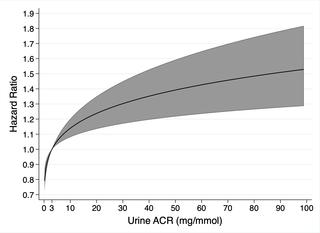Our official English website, www.x-mol.net, welcomes your
feedback! (Note: you will need to create a separate account there.)
Association between non-malignant monoclonal gammopathy and adverse outcomes in chronic kidney disease: A cohort study.
PLOS Medicine ( IF 10.5 ) Pub Date : 2020-02-28 , DOI: 10.1371/journal.pmed.1003050 Anthony Fenton 1, 2 , Rajkumar Chinnadurai 3 , Latha Gullapudi 4 , Petros Kampanis 5 , Indranil Dasgupta 1 , James Ritchie 3 , Stephen Harding 5 , Charles J Ferro 1 , Philip A Kalra 3 , Maarten W Taal 4 , Paul Cockwell 1, 2
PLOS Medicine ( IF 10.5 ) Pub Date : 2020-02-28 , DOI: 10.1371/journal.pmed.1003050 Anthony Fenton 1, 2 , Rajkumar Chinnadurai 3 , Latha Gullapudi 4 , Petros Kampanis 5 , Indranil Dasgupta 1 , James Ritchie 3 , Stephen Harding 5 , Charles J Ferro 1 , Philip A Kalra 3 , Maarten W Taal 4 , Paul Cockwell 1, 2
Affiliation

|
BACKGROUND
In studies including the general population, the presence of non-malignant monoclonal gammopathy (MG) can be causally associated with kidney damage and shorter survival. We assessed whether the presence of an MG is associated with a higher risk of kidney failure or death in individuals with chronic kidney disease (CKD).
METHODS AND FINDINGS
Data were used from 3 prospective cohorts of individuals with CKD (not on dialysis or with a kidney transplant): (1) Renal Impairment in Secondary Care (RIISC, Queen Elizabeth Hospital and Heartlands Hospital, Birmingham, UK, N = 878), (2) Salford Kidney Study (SKS, Salford Royal Hospital, Salford, UK, N = 861), and (3) Renal Risk in Derby (RRID, Derby, UK, N = 1,739). Participants were excluded if they had multiple myeloma or any other B cell lymphoproliferative disorder with end-organ damage. Median age was 71.0 years, 50.6% were male, median estimated glomerular filtration rate was 42.3 ml/min/1.73 m2, and median urine albumin-to-creatinine ratio was 3.4 mg/mmol. All non-malignant MG was identified in the baseline serum of participants of RIISC. Further, light chain MG (LC-MG) was identified and studied in participants of RIISC, SKS, and RRID. Participants were followed up for kidney failure (defined as the initiation of dialysis or kidney transplantation) and death. Associations with the risk of kidney failure were estimated by competing-risks regression (handling death as a competing risk), and associations with death were estimated by Cox proportional hazards regression. In total, 102 (11.6%) of the 878 RIISC participants had an MG. During a median follow-up time of 74.0 months, there were 327 kidney failure events and 202 deaths. The presence of MG was not associated with risk of kidney failure (univariable subhazard ratio [SHR] 0.97 [95% CI 0.68 to 1.38], P = 0.85; multivariable SHR 1.16 [95% CI 0.80 to 1.69], P = 0.43), and although there was a higher risk of death in univariable analysis (hazard ratio [HR] 2.13 [95% CI 1.49 to 3.02], P < 0.001), this was not significant in multivariable analysis (HR 1.37 [95% CI 0.93 to 2.00], P = 0.11). Fifty-five (1.6%) of the 3,478 participants from all 3 studies had LC-MG. During a median follow-up time of 62.5 months, 564 of the 3,478 participants progressed to kidney failure, and 803 died. LC-MG was not associated with risk of kidney failure (univariable SHR 1.07 [95% CI 0.58 to 1.96], P = 0.82; multivariable SHR 1.42 [95% CI 0.78 to 2.57], P = 0.26). There was a higher risk of death in those with LC-MG in the univariable model (HR 2.51 [95% CI 1.59 to 3.96], P < 0.001), but not in the multivariable model (HR 1.49 [95% CI 0.93 to 2.39], P = 0.10). An important limitation of this work was that only LC-MG, rather than any MG, could be identified in participants from SKS and RRID.
CONCLUSIONS
The prevalence of MG was higher in this CKD cohort than that reported in the general population. However, the presence of an MG was not independently associated with a significantly higher risk of kidney failure or, unlike in the general population, risk of death.
中文翻译:

非恶性单克隆丙种球蛋白病与慢性肾脏疾病不良结局之间的关联:一项队列研究。
背景技术在包括普通人群在内的研究中,非恶性单克隆丙种球蛋白病(MG)的存在可能与肾脏损害和生存期缩短有因果关系。我们评估了MG的存在是否与患有慢性肾脏病(CKD)的个体发生肾功能衰竭或死亡的风险较高相关。方法和结果使用来自3个有CKD(未接受透析或肾脏移植)的前瞻性队列数据:(1)二级保健中的肾功能不全(英国伯明翰伊丽莎白女王医院和心脏医院医院RIISC,N = 878) ),(2)Salford肾脏研究(SKS,英国Salford的Salford皇家医院,N = 861),以及(3)Derby的肾脏风险(RRID,英国Derby,N = 1,739)。如果参与者患有多发性骨髓瘤或任何其他具有终末器官损害的B细胞淋巴增生性疾病,则将其排除在外。中位年龄为71.0岁,男性为50.6%,中位肾小球滤过率中位数为42.3 ml / min / 1.73 m2,尿白蛋白与肌酐的中位数为3.4 mg / mmol。在RIISC参与者的基线血清中鉴定出所有非恶性MG。此外,在RIISC,SKS和RRID的参与者中确定并研究了轻链MG(LC-MG)。对参与者进行肾脏衰竭(定义为开始透析或肾脏移植)和死亡的随访。通过竞争风险回归(将死亡视为竞争风险)评估与肾衰竭风险的关联,并通过Cox比例风险回归评估与死亡的关联。总共878名RIISC参与者中有102名(11.6%)有MG。在74.0个月的中位随访时间内,发生了327例肾功能衰竭事件和202例死亡。MG的存在与肾衰竭的风险无关(单变量亚危险比[SHR] 0.97 [95%CI 0.68至1.38],P = 0.85;多变量SHR 1.16 [95%CI 0.80至1.69],P = 0.43),尽管单变量分析的死亡风险较高(危险比[HR] 2.13 [95%CI 1.49至3.02],P <0.001),但在多变量分析中却无统计学意义(HR 1.37 [95%CI 0.93至2.00] ],P = 0.11)。所有3项研究的3,478名参与者中有55名(1.6%)患有LC-MG。在62.5个月的中位随访时间内,3,478名参与者中有564名进展为肾衰竭,其中803人死亡。LC-MG与肾衰竭风险无关(单变量SHR 1.07 [95%CI 0.58至1.96],P = 0.82;多变量SHR 1.42 [95%CI 0.78至2.57],P = 0.26)。在单变量模型中,LC-MG患者的死亡风险更高(HR 2.51 [95%CI 1.59至3.96],P <0.001),但在多变量模型中则没有(HR 1.49 [95%CI 0.93至2.39] ],P = 0.10)。这项工作的重要局限性在于,只能从SKS和RRID的参与者中识别出LC-MG,而不是任何MG。结论该CKD队列中MG的患病率高于一般人群。但是,MG的存在与肾衰竭的风险明显升高或死亡的风险不相关,与普通人群不同。可以从SKS和RRID的参与者中识别出来。结论该CKD队列中MG的患病率高于一般人群。但是,MG的存在与肾衰竭的风险明显升高或死亡的风险不相关,与普通人群不同。可以从SKS和RRID的参与者中识别出来。结论该CKD队列中MG的患病率高于一般人群。但是,MG的存在与肾衰竭的风险明显升高或死亡的风险不相关,与普通人群不同。
更新日期:2020-03-02
中文翻译:

非恶性单克隆丙种球蛋白病与慢性肾脏疾病不良结局之间的关联:一项队列研究。
背景技术在包括普通人群在内的研究中,非恶性单克隆丙种球蛋白病(MG)的存在可能与肾脏损害和生存期缩短有因果关系。我们评估了MG的存在是否与患有慢性肾脏病(CKD)的个体发生肾功能衰竭或死亡的风险较高相关。方法和结果使用来自3个有CKD(未接受透析或肾脏移植)的前瞻性队列数据:(1)二级保健中的肾功能不全(英国伯明翰伊丽莎白女王医院和心脏医院医院RIISC,N = 878) ),(2)Salford肾脏研究(SKS,英国Salford的Salford皇家医院,N = 861),以及(3)Derby的肾脏风险(RRID,英国Derby,N = 1,739)。如果参与者患有多发性骨髓瘤或任何其他具有终末器官损害的B细胞淋巴增生性疾病,则将其排除在外。中位年龄为71.0岁,男性为50.6%,中位肾小球滤过率中位数为42.3 ml / min / 1.73 m2,尿白蛋白与肌酐的中位数为3.4 mg / mmol。在RIISC参与者的基线血清中鉴定出所有非恶性MG。此外,在RIISC,SKS和RRID的参与者中确定并研究了轻链MG(LC-MG)。对参与者进行肾脏衰竭(定义为开始透析或肾脏移植)和死亡的随访。通过竞争风险回归(将死亡视为竞争风险)评估与肾衰竭风险的关联,并通过Cox比例风险回归评估与死亡的关联。总共878名RIISC参与者中有102名(11.6%)有MG。在74.0个月的中位随访时间内,发生了327例肾功能衰竭事件和202例死亡。MG的存在与肾衰竭的风险无关(单变量亚危险比[SHR] 0.97 [95%CI 0.68至1.38],P = 0.85;多变量SHR 1.16 [95%CI 0.80至1.69],P = 0.43),尽管单变量分析的死亡风险较高(危险比[HR] 2.13 [95%CI 1.49至3.02],P <0.001),但在多变量分析中却无统计学意义(HR 1.37 [95%CI 0.93至2.00] ],P = 0.11)。所有3项研究的3,478名参与者中有55名(1.6%)患有LC-MG。在62.5个月的中位随访时间内,3,478名参与者中有564名进展为肾衰竭,其中803人死亡。LC-MG与肾衰竭风险无关(单变量SHR 1.07 [95%CI 0.58至1.96],P = 0.82;多变量SHR 1.42 [95%CI 0.78至2.57],P = 0.26)。在单变量模型中,LC-MG患者的死亡风险更高(HR 2.51 [95%CI 1.59至3.96],P <0.001),但在多变量模型中则没有(HR 1.49 [95%CI 0.93至2.39] ],P = 0.10)。这项工作的重要局限性在于,只能从SKS和RRID的参与者中识别出LC-MG,而不是任何MG。结论该CKD队列中MG的患病率高于一般人群。但是,MG的存在与肾衰竭的风险明显升高或死亡的风险不相关,与普通人群不同。可以从SKS和RRID的参与者中识别出来。结论该CKD队列中MG的患病率高于一般人群。但是,MG的存在与肾衰竭的风险明显升高或死亡的风险不相关,与普通人群不同。可以从SKS和RRID的参与者中识别出来。结论该CKD队列中MG的患病率高于一般人群。但是,MG的存在与肾衰竭的风险明显升高或死亡的风险不相关,与普通人群不同。











































 京公网安备 11010802027423号
京公网安备 11010802027423号